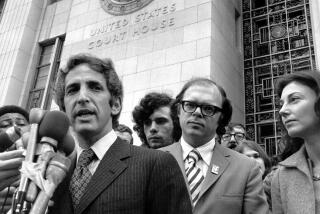Pictures imperfect
Readers of this newspaper were mesmerized this week by staff photographer Luis Sinco’s two-part series about Lance Cpl. James Blake Miller, the man behind his now famous portrait, “Marlboro Marine.” Taken in 2004 during the battle of Fallouja, the photograph shows a weary Marine staring into the morning sun. His face is smeared with mud, the bridge of his nose is bloodied, and a cigarette dangles from his lips with a Bogart-style insouciance we rarely see anymore.
Sinco’s photograph, which appeared on the front pages of 160 newspapers and was a finalist for a Pulitzer Prize, is among the most celebrated photographs from the Iraq war to date. It is also, to my mind, the least consistent with the predominant aesthetic of the images that define this war. And that may be why we like it so much.
Despite all the professional “shooters” doing their best to cover the war, much of the action we see is brought to us by the people doing the fighting. Soldiers record artillery fire with hand-held digital video recorders and post the clips on YouTube. Snapshots taken with cellphones -- some as innocuous as tourist photos, others downright gruesome -- abound on the Internet. In other words, to look at photographs of the Iraq war is, quite often, to see guerrilla photojournalism.
In fact, it’s worth noting that many of the war’s most memorable photographs have come from nonprofessionals who, in true 21st century fashion, just happen to carry cameras with them most of the time. While certain recognizable moments -- the toppling of the statue of Saddam Hussein in Baghdad in 2003, for example -- were well documented by the pros, there are other familiar images that look as though the person who took them was more interested in having a souvenir than producing a historical document. Sure, we remember the news photos of the dapper, combative Hussein at his trial. But who can forget the infamous images of the imprisoned Hussein in his underwear, which appeared to have been taken by someone who just wanted some really cool pictures to e-mail home?
Then, of course, there are the Abu Ghraib photos. They may permanently remain the most iconic images of the war, and a few in particular will likely become signature documents of the 21st century. But what are we to make of the fact that the images came out not because a photojournalist was there and made a decision -- used his or her trained eye -- to take pictures, but because a handful of very disturbed people decided to show off?
Historically speaking, the images from Abu Ghraib are every bit as important as the most famous images from the Vietnam War -- for example, Nick Ut’s photograph of a naked girl running down the road after a napalm attack on her village in 1972, or Eddie Adams’ photograph of Lt. Col. Nguyen Ngoc Loan executing a Viet Cong prisoner in 1968. But they don’t look as important. It’s not just that everything has more gravitas in black and white. It’s that the people taking the Abu Ghraib pictures were not doing so as witnesses or communicators or artists (a professional photojournalist is all three at once) but as gloaters. The result is that a human rights debacle is documented in a style more appropriate to spring break beer-chugging contests in Cancun.
As for a lot of the other footage from Iraq, it too embodies a mise-en-scene that might be described as the YouTube New Wave. When I called Sinco to ask why this was, he pointed out another piece of this equation, which is that the Pentagon is now running a much tighter public relations ship than it did during Vietnam. Between that and the dangers to journalists in general in Iraq, the professionals can’t always get to where the most effective shots might be, and they aren’t taking or transmitting as many pictures as they might otherwise.
“From colleagues I’ve talked to, it sounded like in Vietnam you could catch a helicopter anywhere in the country,” Sinco told me. “It’s a totally different deal now . . . there’s a censorship mechanism in place. [The military] does not want another shot of a kid crying over his dead parents.”
As for the Marlboro Marine photo (which prompted the military to offer Miller an early discharge, lest this poster boy ended up wounded or dead; Miller refused), Sinco suggests that people love it because the subject’s face shows the full spectrum of emotions and they can pick and choose from any of them. “The pro-war crowd saw patriotism,” he said. “The antiwar crowd saw a damaged person.”
But I’m still inclined to think that many of us, regardless of our position on the war, were drawn to the photograph simply because it looked so different from what we’re used to seeing from Iraq. Unlike a seat-of-the-pants snapshot from a cellphone, it bore the hallmarks of a photographer who, even in the heat of battle when he’s shooting like crazy, knows what he’s doing. In a war in which people increasingly seem to feel they don’t know what they’re doing, that’s a powerful message, a powerful illusion. And what is great photography if not that?
More to Read
Sign up for Essential California
The most important California stories and recommendations in your inbox every morning.
You may occasionally receive promotional content from the Los Angeles Times.











